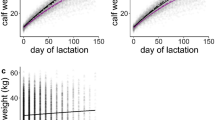Abstract
This study tested whether fallow deer mothers, Dama dama, bias their investment towards sons and, thus, whether sons are more costly to produce than daughters. Young (2 years) and old (≥3 years) hinds were analysed separately. Old hinds who raised sons accumulated less body mass than those who raised daughters, during the period between late gestation and the end of lactation. This difference in body mass persisted to the following spring. Mothers who had raised sons gave birth later and their offspring's pre-winter mass was lower the following year than for mothers who had raised daughters. These results indicate higher expenditure for hinds who raise sons and support theories of male-biased maternal investment. However, young mothers with sons and those with daughters did not differ in reproductive performance the following year. One reason might be that young mothers are close to the maximum level of maternal expenditure, since they are still growing, and cannot invest any extra resources in sons.
Similar content being viewed by others
Author information
Authors and Affiliations
Additional information
Received: 28 August 1997 / Accepted after revision: 5 April 1998
Rights and permissions
About this article
Cite this article
Birgersson, B. Male-biased maternal expenditure and associated costs in fallow deer. Behav Ecol Sociobiol 43, 87–93 (1998). https://doi.org/10.1007/s002650050470
Issue Date:
DOI: https://doi.org/10.1007/s002650050470




